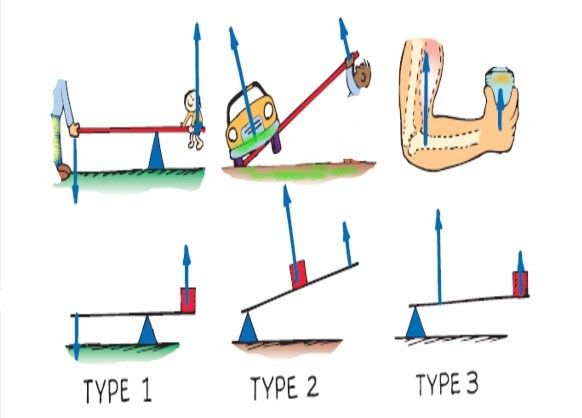Conservation of energy in Levers
In this post, we will discuss how the conservation of energy is maintained in levers and other machines. A machine is a device used to multiply forces or simply to change the direction of forces. The concept that underlies every machine is the conservation of energy. A machine cannot put out more energy than is put into it. A machine cannot create energy.
A machine transfers energy from one place to another or transforms it from one form to another.
Let’s consider one of the simplest machines, the lever, for discussion.
work input = work output ( lever – case study )
A lever is a simple machine made of a bar that turns about a fixed point.

Let’s first consider one specific type of lever (type 1) as shown in Figure 1.
If you see the lever in figure 1, we do work on one end of the lever by applying input force (here on the left side of figure 1), the other end does work on the load with the output force (at the right side of figure 1).
We see that the direction of force is changed. The input force is downwards, and the output force on the load is upwards.
If we push down, the load is lifted up.
If the heat from the friction is small enough to neglect, the work input will be equal to the work output.
work input = work output
Since work equals force times distance, we can say:
input force x displacement of the effort end = output force x displacement of the load
If the pivot point, or fulcrum, of the type 1 lever, is maintained relatively close to the load, then a small input force exerted through a large distance will produce a large output force over a correspondingly short distance. In this way, the type 1 lever can multiply forces at the expense of distance. However, as per conservation of energy, a machine can’t multiply work or energy.
3 types of levers & conservation of energy
Three common ways to set up a lever are shown in Figure 2.

Type 1 lever & conservation of energy
A type 1 lever has the fulcrum between the force and the load, or between input and output. This kind of lever is commonly seen in a playground seesaw with children sitting on each end of it. Push down on one end and you lift a load at the other. You can increase the force at the expense of distance. Note that the directions of input and output are opposite.
Type 2 lever & conservation of energy
For a type 2 lever, the load is between the fulcrum and the input force. To lift a load, you lift the end of the lever. One example is placing one end of a long steel bar under an automobile frame and lifting it on the free end to raise the automobile. Again, force on the load is increased at the expense of distance. Since the input and output forces are on the same side of the fulcrum, the forces have the same direction.
Type 3 lever & conservation of energy
In the type 3 lever, the fulcrum is at one end and the load is at the other. The input force is applied between them. Our biceps muscles are connected to the bones in our forearm in this way. The fulcrum is our elbow and the load is in our hand. The type 3 lever increases the distance at the expense of force. When we move our biceps muscles a short distance, our hand moves a much greater distance. The input and output forces are on the same side of the fulcrum and therefore they have the same direction.
Take Away
A machine transfers energy from one place to another or transforms it from one form to another. But, a machine can’t multiply work or energy. Levers are simple machines, and like all other machines can’t multiply work or energy. Thus, conservation of energy is fully maintained in levers.
Some levers (type 1 & 2) can multiply forces but at the expense of distance.
